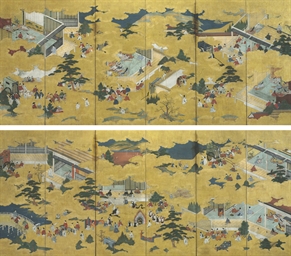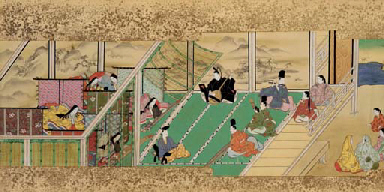ANONYMOUS (18TH CENTURY) EMPEROR QIANLONG'S REVIEW OF THE GRAND PARADE OF TROOPS Handscroll, ink and colour with gold on silk 68 x approximately 1550 cm. (26 3/4 x approximately 610 in.) Inscribed at the end of the scroll: Scroll Three - Review of Grand Parade Fifteen collector's seals of the Emperor Qianlong (reigned 1736-1795): San Xi Tang Jin Jian Xi, Yi Zi Sun, Qian Long Jian Shang, Zhong Hua Gong Jian Cang Bao, Qian Long Yu Lang Zhi Bao, Shi Qu Bao Ji, Bao Ji Ding Jian, Bao Ji Zhong Bian (complete set of eight collection seals), Wu Fu Wu Dai Tang Gu Xi Tian Zi, Ba Zheng Mao Nian Zhi Bao, Tai Shang Huang Di Zhi Bao, Ji Xi You Yu Xiang, Luo Zhi Yun Yan, Han Ying Zui Hua, Bi Duan Chun Yu With Qing imperial kesi scroll wrap of dragon amongst clouds design, with woven titleslip reading: Dayue Disan Tu, Yue Zhen , (Review of Grand Parade of Troops, Scroll Three, The Review) Original Qing imperial gold ground brocade outer wrap with two dragons around a flaming pearl pattern Note: The emperor Qianlong chose to review his troops in Nanyuan (South Park) in the fourth year of his reign, and this took place in the eleventh month of the jiwei year, 1739. A precedent was set for a review of the troops every three years. The order to paint and record this occasion came seven years later in the eleventh year of Qianlong's reign, when Jin Kun (active circa 1662-1746) was appointed to lead a team of ten court painters in this task. A series of four large handscrolls was painted, each depicting certain events of the review which took place over several days. The first scroll depicts the emperor's arrival, the second the formation of the parade, the third the actual review, and the fourth the grand finale. Each scroll ends with a long inscription detailing the secnes depicted. (See Shiqu Baoji Xubian , juan (chapter) 35, in Midian Zhulin Shiqu Baoji Hebian, Shanghai Bookstore Publishing, 1988, vol.5, pp.1871-1875). Of the four scrolls, the whereabouts of only two are known, the present lot which is the third, and the second scroll of the parada formation in the Palace Museum, Beijing (See Nie Chongzheng et. al., Qingdai Gongting Huihua (Qing Court Paintings), Hong Kong, 1996 pp. 157-163, and Court Painting of the Qing Dynasty , Cultural Relics Publishing House, Beijing 1992, pp.158-9, 257). The second and third scrolls are almost identical, with the exception that the second scroll concerns only the parade and the emperor is not seen, whereas the present third scroll describes the same parade formation with the emperor present reviewing his troops. The Qing army is divided into eight 'brigades', each distinguished by the colour of their banner. The eight colours are yellow, white, red, blue, yellow-inlaid, white-inlaid, red-inlaid, and blue-inlaid. The white, yellow-inlaid, and yellow bannered brigades are the upper three brigades, also known as the Neifu Sanqi (the three banners of the imperial court), consisting of members of the Qing-Mongol aristocracy. Troops are arranged by brigades in the parade. For a viewer of this scroll, they are arranged from the start of the scroll in colour sequence of blue, white-inlaid, white, yellow-inlaid, yellow, red, red-inlaid, and blue-inlaid. Each battalion is further sub-divided by battalions such as the cavalry, cordons, and so on. Every detail in the formation of the parada down to the patterns and colours of each banner, the dress and accoutrements of each soldier, is prescribed and strictly adhered to. On the appointed day, the emperor dressed in full military regalia leaves his temporary royal residence in Nanyuan and travels on horseback to reach the royal marquee set up on Liangying Tai . He rides from the marquee through the parade to inspect the troops. His entourage includes bodyguards, officials, and generals, forming two single lines in front to herald the arrival of the monarch, and the rest falls into five concentric semi-circles in the rear. On completing his inspection, the emperor
ANONYMOUS (18TH CENTURY) EMPEROR QIANLONG'S REVIEW OF THE GRAND PARADE OF TROOPS Handscroll, ink and colour with gold on silk 68 x approximately 1550 cm. (26 3/4 x approximately 610 in.) Inscribed at the end of the scroll: Scroll Three - Review of Grand Parade Fifteen collector's seals of the Emperor Qianlong (reigned 1736-1795): San Xi Tang Jin Jian Xi, Yi Zi Sun, Qian Long Jian Shang, Zhong Hua Gong Jian Cang Bao, Qian Long Yu Lang Zhi Bao, Shi Qu Bao Ji, Bao Ji Ding Jian, Bao Ji Zhong Bian (complete set of eight collection seals), Wu Fu Wu Dai Tang Gu Xi Tian Zi, Ba Zheng Mao Nian Zhi Bao, Tai Shang Huang Di Zhi Bao, Ji Xi You Yu Xiang, Luo Zhi Yun Yan, Han Ying Zui Hua, Bi Duan Chun Yu With Qing imperial kesi scroll wrap of dragon amongst clouds design, with woven titleslip reading: Dayue Disan Tu, Yue Zhen , (Review of Grand Parade of Troops, Scroll Three, The Review) Original Qing imperial gold ground brocade outer wrap with two dragons around a flaming pearl pattern Note: The emperor Qianlong chose to review his troops in Nanyuan (South Park) in the fourth year of his reign, and this took place in the eleventh month of the jiwei year, 1739. A precedent was set for a review of the troops every three years. The order to paint and record this occasion came seven years later in the eleventh year of Qianlong's reign, when Jin Kun (active circa 1662-1746) was appointed to lead a team of ten court painters in this task. A series of four large handscrolls was painted, each depicting certain events of the review which took place over several days. The first scroll depicts the emperor's arrival, the second the formation of the parade, the third the actual review, and the fourth the grand finale. Each scroll ends with a long inscription detailing the secnes depicted. (See Shiqu Baoji Xubian , juan (chapter) 35, in Midian Zhulin Shiqu Baoji Hebian, Shanghai Bookstore Publishing, 1988, vol.5, pp.1871-1875). Of the four scrolls, the whereabouts of only two are known, the present lot which is the third, and the second scroll of the parada formation in the Palace Museum, Beijing (See Nie Chongzheng et. al., Qingdai Gongting Huihua (Qing Court Paintings), Hong Kong, 1996 pp. 157-163, and Court Painting of the Qing Dynasty , Cultural Relics Publishing House, Beijing 1992, pp.158-9, 257). The second and third scrolls are almost identical, with the exception that the second scroll concerns only the parade and the emperor is not seen, whereas the present third scroll describes the same parade formation with the emperor present reviewing his troops. The Qing army is divided into eight 'brigades', each distinguished by the colour of their banner. The eight colours are yellow, white, red, blue, yellow-inlaid, white-inlaid, red-inlaid, and blue-inlaid. The white, yellow-inlaid, and yellow bannered brigades are the upper three brigades, also known as the Neifu Sanqi (the three banners of the imperial court), consisting of members of the Qing-Mongol aristocracy. Troops are arranged by brigades in the parade. For a viewer of this scroll, they are arranged from the start of the scroll in colour sequence of blue, white-inlaid, white, yellow-inlaid, yellow, red, red-inlaid, and blue-inlaid. Each battalion is further sub-divided by battalions such as the cavalry, cordons, and so on. Every detail in the formation of the parada down to the patterns and colours of each banner, the dress and accoutrements of each soldier, is prescribed and strictly adhered to. On the appointed day, the emperor dressed in full military regalia leaves his temporary royal residence in Nanyuan and travels on horseback to reach the royal marquee set up on Liangying Tai . He rides from the marquee through the parade to inspect the troops. His entourage includes bodyguards, officials, and generals, forming two single lines in front to herald the arrival of the monarch, and the rest falls into five concentric semi-circles in the rear. On completing his inspection, the emperor

.jpg)













Try LotSearch and its premium features for 7 days - without any costs!
Be notified automatically about new items in upcoming auctions.
Create an alert